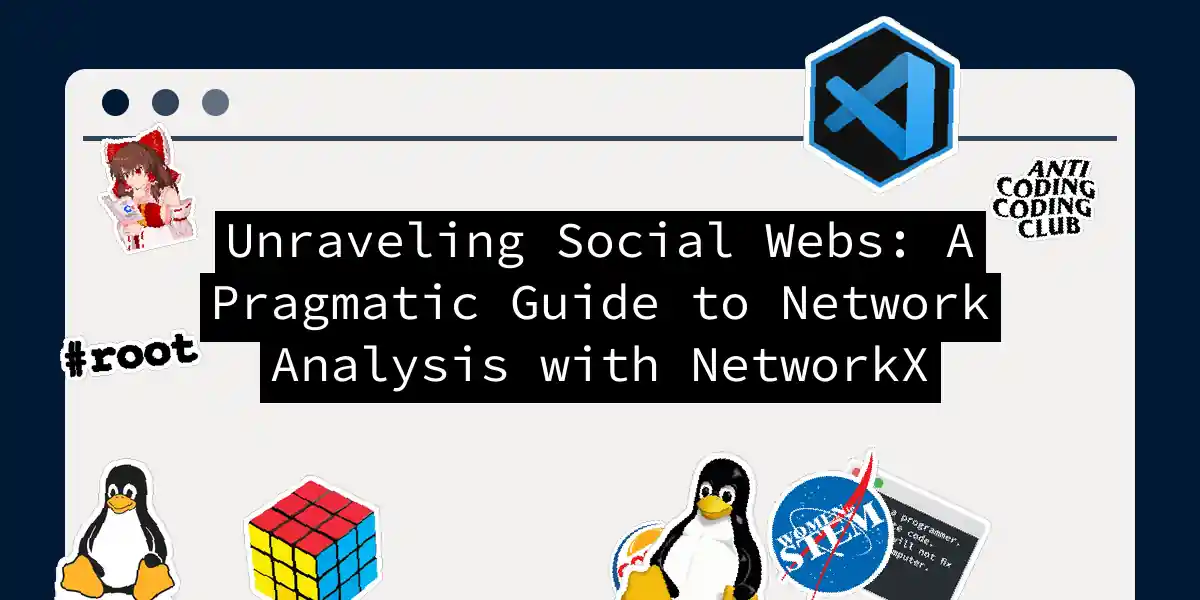Ever feel like you’re drowning in social connections? Whether you’re analyzing Beyoncé’s fan network or your office coffee clique, NetworkX turns the tangled spaghetti of relationships into laser-cut lasagna. Let’s build a social network analysis pipeline that even Kevin Bacon would applaud.
🛠️ Setting Up Your Digital Detective Kit
Before playing Sherlock Holmes of social graphs, arm yourself with Python and NetworkX:
pip install networkx matplotlib pandas
Pro tip: If your computer groans at “pip”, whisper “conda” instead - it’s like giving your machine espresso. For Anaconda users:
conda install -c anaconda networkx
🌐 Loading Your Social Canvas
We’ll use the classic Facebook ego network dataset from Stanford - 4,039 users and 88,234 friendships. Download facebook_combined.txt from Stanford’s repository, then:
import networkx as nx
# Load the Facebook social graph
G_fb = nx.read_edgelist(
"facebook_combined.txt",
create_using=nx.Graph(),
nodetype=int
)
print(nx.info(G_fb))
This cranks out:
Name:
Type: Graph
Number of nodes: 4039
Number of edges: 88234
Average degree: 43.6910
🔍 The Social Autopsy
Degree Distribution: Who’s the Popular Kid?
degrees = [deg for _, deg in G_fb.degree()]
print(f"Max degree: {max(degrees)}")
print(f"Min degree: {min(degrees)}")
print(f"Average friends: {sum(degrees)/len(degrees):.2f}")
Betweenness Centrality: The Social Bridges
These operators connect disparate groups:
betweenness = nx.betweenness_centrality(G_fb)
top_5_brokers = sorted(betweenness.items(), key=lambda x: x, reverse=True)[:5]
print("Top 5 connectors:", top_5_brokers)
Community Detection: Finding Your Tribe
Real networks form cliques like teens at a mall. Use the Louvain method:
import community as louvain
partition = louvain.best_partition(G_fb)
community_count = max(partition.values()) + 1
print(f"Found {community_count} natural communities")
🎨 Visualizing the Invisible
Warning: Visualizing 4,000+ nodes makes even supercomputers sweat. Instead, sample intelligently:
import matplotlib.pyplot as plt
from networkx import spring_layout
# Focus on top 1% most connected users
top_connectors = sorted(G_fb.degree, key=lambda x: x, reverse=True)[:40]
subgraph = G_fb.subgraph([node for node, _ in top_connectors])
plt.figure(figsize=(14, 10))
pos = spring_layout(subgraph, seed=42)
nx.draw(subgraph, pos, node_size=800, with_labels=True)
plt.title("Facebook Power Connectors")
plt.show()
💡 Practical Applications (Beyond Stalking)
- Crisis Response: Map information flow during disasters
- Marketing: Identify brand ambassadors in influencer networks
- Security: Detect unusual communication patterns
- HR: Analyze collaboration networks in organizations
🔮 Parting Wisdom
Social networks are like onions - they have layers, make you cry, and occasionally smell funny. With NetworkX, you’ve got the knife to peel them. Remember: In the graph of life, be the node that connects communities, not just the one with shiny edges.
“Analyzing networks without NetworkX is like baking without an oven - possible, but why suffer?” - Ancient Data Proverb
